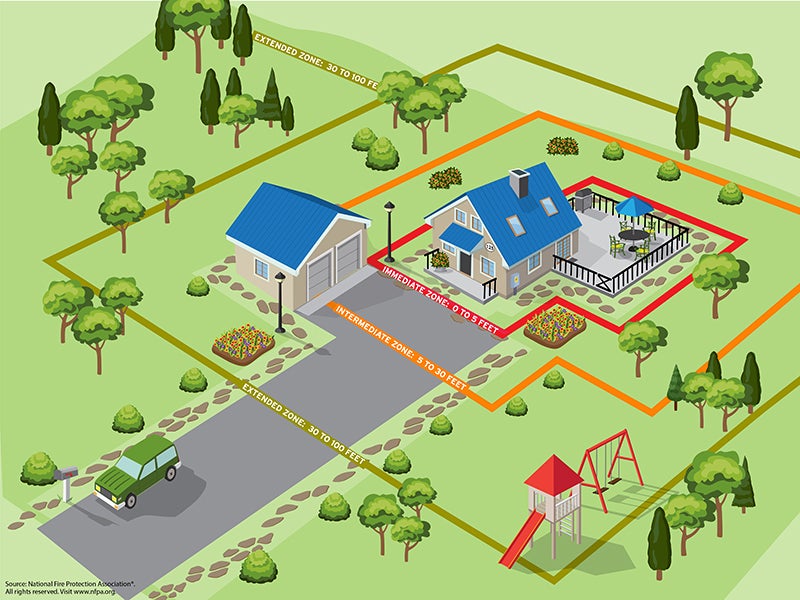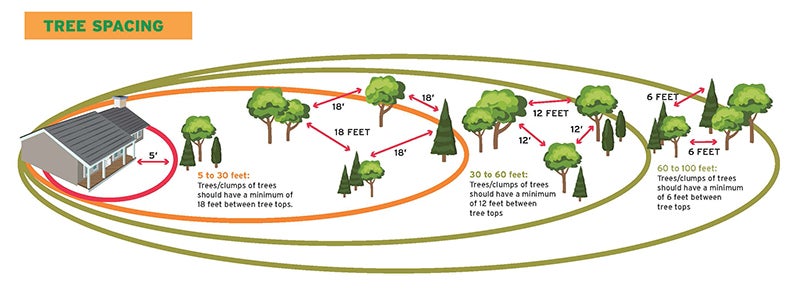Preparing Your Home for Wildfire Season
To increase your home’s chance of surviving a wildfire, choose fire-resistant building materials and limit the amount of flammable vegetation in the three home ignition zones. The zones include the Immediate Zone: (0 to 5 feet around the house), the Intermediate Zone (5 to 30 feet), and the Extended Zone (30 to 100 feet).

Immediate zone
The home and the area 0-5’ from the furthest attached exterior point of the home; defined as a non-combustible area. Science tells us this is the most important zone to take immediate action on as it is the most vulnerable to embers. START WITH THE HOUSE ITSELF then move into the landscaping section of the Immediate Zone.
- Clean roofs and gutters of dead leaves, debris and pine needles that could catch embers.
- Replace or repair any loose or missing shingles or roof tiles to prevent ember penetration.
- Reduce embers that could pass through vents in the eaves by installing 1/8 inch metal mesh screening.
- Clean debris from exterior attic vents and install 1/8 inch metal mesh screening to reduce embers.
- Repair or replace damaged or loose window screens and any broken windows Screen or box-in areas below patios and decks with wire mesh to prevent debris and combustible materials from accumulating.
- Move any flammable material away from wall exteriors – mulch, flammable plants, leaves and needles, firewood piles – anything that can burn. Remove anything stored underneath decks or porches.
Intermediate zone
5-30’ from the furthest exterior point of the home. Landscaping/hardscaping- employing careful landscaping or creating breaks that can help influence and decrease fire behavior
- Clear vegetation from under large stationary propane tanks.
- Create fuel breaks with driveways, walkways/paths, patios, and decks.
- Keep lawns and native grasses mowed to a height of four inches.
- Remove ladder fuels (vegetation under trees) so a surface fire cannot reach the crowns. Prune trees up to six to ten feet from the ground; for shorter trees do not exceed 1/3 of the overall tree height.
- Space trees to have a minimum of eighteen feet between crowns with the distance increasing with the percentage of slope.
- Tree placement should be planned to ensure the mature canopy is no closer than ten feet to the edge of the structure.
- Tree and shrubs in this zone should be limited to small clusters of a few each to break up the continuity of the vegetation across the landscape.
Extended zone
30-100 feet, out to 200 feet. Landscaping – the goal here is not to eliminate fire but to interrupt fire’s path and keep flames smaller and on the ground.
- Dispose of heavy accumulations of ground litter/debris.
- Remove dead plant and tree material.
- Remove small conifers growing between mature trees.
- Remove vegetation adjacent to storage sheds or other outbuildings within this area.
- Trees 30 to 60 feet from the home should have at least 12 feet between canopy tops.*
- Trees 60 to 100 feet from the home should have at least 6 feet between the canopy tops.*

*The distances listed for crown spacing are suggested based on NFPA 1144. However, the crown spacing needed to reduce/prevent crown fire potential could be significantly greater due to slope, the species of trees involved and other site specific conditions. Check with your local forestry professional to get advice on what is appropriate for your property. Source: NFPA - Preparing homes for wildfire
Wildfire Evacuation Guide
With large wildland fire events occurring nearly each summer, evacuations from neighborhoods have become commonplace during these events. Central Oregon is no stranger to wildland fire. Along with the beautiful mountains, lakes, and rivers, we also enjoy a varied landscape that provides a rich forested setting for business and recreation and increasingly, homes. It is this interface between development and the forested landscape that increases the risk of great losses due to wildland fire. During a major wildland fire, despite the best efforts of fire protection and law enforcement agencies, there still may not be enough equipment and manpower to go door-to-door advising you to evacuate; you should be ready to make this decision yourself.
Local Fire Agencies are responsible for determining when the need for evacuation exists and the Deschutes County Sheriffs Department and other law enforcement agencies are responsible for carrying out an ordered evacuation.
During an evacuation, roads become congested with vehicles, dust and smoke, making evacuations a slow process. GO EARLY
Long before evacuation seems likely, READY, SET and GO!'
Deschutes County Evacuation Map: deschutes.org/emergency
What Does PSPS Mean for MEC Members?
A Public Safety Power Shutoff (PSPS) is a preventative operation that utilities can use to help ensure their equipment does not start or contribute to wildfires during red flag conditions. Red flag warnings are issued by the National Weather Service when strong gusty winds are combined with high temperatures and low humidity.
During red flag conditions, MEC’s management staff will evaluate the conditions and take actions that are deemed appropriate. Our electrical system is well-maintained and our right of ways are in the best shape we have seen in years. Therefore, in most cases, placing our system on a high sensitivity setting will be our first line of defense. Only under imminent danger to life or property will MEC implement a PSPS. Examples of this would be if a fire has started and fire-fighting crews need the power shut off for their safety or if lines are on the ground that are energized.
To learn more about PSPS events, protocols, and how to prepare, click here.

